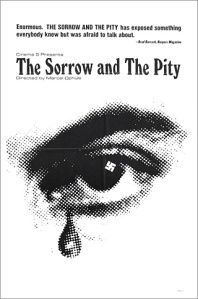 Thanks in part to Woody Allen’s ironic references to it in Annie Hall, Marcel Ophuls’s The Sorrow and the Pity probably enjoys a higher profile than its serious subject and approach would warrant in these days dedicated to trivia. Almost universally acclaimed when it was released, the film has acquired something like legendary status, to the point that you have to wonder how many people have actually watched it lately? At over four hours long, it’s not likely to entrance viewers who have difficulty sitting through a 30 second commercial. It is tempting to suggest, in other words, that Sorrow is in danger of becoming a waxworks classic to which everyone pays tribute without watching or questioning it.
Thanks in part to Woody Allen’s ironic references to it in Annie Hall, Marcel Ophuls’s The Sorrow and the Pity probably enjoys a higher profile than its serious subject and approach would warrant in these days dedicated to trivia. Almost universally acclaimed when it was released, the film has acquired something like legendary status, to the point that you have to wonder how many people have actually watched it lately? At over four hours long, it’s not likely to entrance viewers who have difficulty sitting through a 30 second commercial. It is tempting to suggest, in other words, that Sorrow is in danger of becoming a waxworks classic to which everyone pays tribute without watching or questioning it.
It is worth noting, for example, that Sorrow is a “film” only in the sense that it was released theatrically when banned from broadcast on French television. That point is worth noting because its length, complexity and questioning method have far more in common with television production than fiction features. Without denying the film’s importance, many of its distinctions stand out only against the hidebound, ultra-conservative world of narrative features.
Moreover, much of Sorrow’s controversial content today seems less than shocking, in no small part because of its own success in tearing the veil from a dark moment in French history. The central thesis, that the French narrative of heroic resistance to the Occupation was at best a highly selective myth, at worst an outright lie, today seems little more than common sense. But it is never easy for anyone to confront and destroy a fiction central to identity, least of all national identity. (Americans are certainly not in a position to point any fingers.)
On a purely formal level, the most interesting thing about Sorrow is how Ophuls combines a synoptic overview with intimate detail. Those who had power (like Anthony Eden and Pierre Mendès-France) provide the political and military context, while “little guys” fill in everyday details with amusing, tragic and ironic anecdotes. Even the people at the top recount engaging stories that bring the past to life in unexpected ways. (The most famous of these is no doubt Mendès-France’s priceless story about his escape from prison.) Interspersed with the interviews and synopses, shots from news and propaganda films, excerpts from fiction features and public performances by well known entertainers provide general cultural and social context.
The cumulative effect is to produce a persuasive, compelling examination of a place and time that never shies from political and moral questions, never loses the thread of forward exposition, and yet also never settles for easy answers or attitudes. We end up feeling we know these people, almost as close friends. To say the film consistently “entertains” risks suggesting that it is superficial. In fact, The Sorrow and the Pity trusts the viewer, engaging our intellects while exciting our moral selves with difficult truths rather than easy identification.
